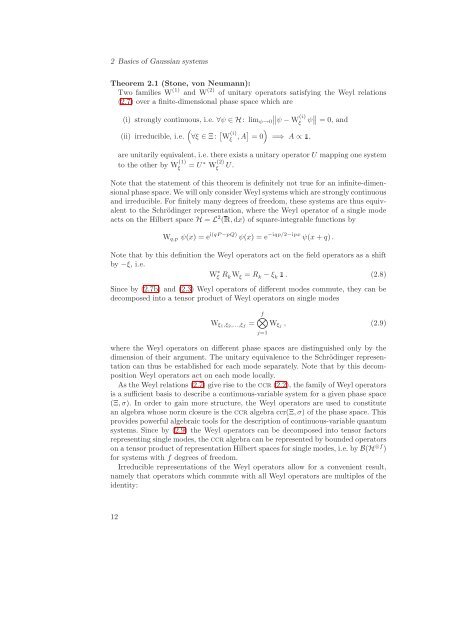Quantum Information Theory with Gaussian Systems
Quantum Information Theory with Gaussian Systems
Quantum Information Theory with Gaussian Systems
Create successful ePaper yourself
Turn your PDF publications into a flip-book with our unique Google optimized e-Paper software.
2 Basics of <strong>Gaussian</strong> systems<br />
Theorem 2.1 (Stone, von Neumann):<br />
Two families W (1) and W (2) of unitary operators satisfying the Weyl relations<br />
(2.7) over a finite-dimensional phase space which are<br />
<br />
(i) strongly continuous, i.e. ∀ψ ∈ H: limψ→0<br />
(ii) irreducible, i.e.<br />
<br />
∀ξ ∈ Ξ: W (i)<br />
ξ , A = 0<br />
<br />
ψ − W (i)<br />
ξ ψ = 0, and<br />
=⇒ A ∝ ,<br />
are unitarily equivalent, i.e. there exists a unitary operator U mapping one system<br />
to the other by W (1)<br />
ξ = U ∗ W (2)<br />
ξ U.<br />
Note that the statement of this theorem is definitely not true for an infinite-dimensional<br />
phase space. We will only consider Weyl systems which are strongly continuous<br />
and irreducible. For finitely many degrees of freedom, these systems are thus equivalent<br />
to the Schrödinger representation, where the Weyl operator of a single mode<br />
acts on the Hilbert space H = L 2 (Ê, dx) of square-integrable functions by<br />
Wq,p ψ(x) = e i(qP −pQ) ψ(x) = e −iqp/2−ipx ψ(x + q).<br />
Note that by this definition the Weyl operators act on the field operators as a shift<br />
by −ξ, i.e.<br />
W ∗ ξ R k W ξ = R k − ξ k . (2.8)<br />
Since by (2.7b) and (2.3) Weyl operators of different modes commute, they can be<br />
decomposed into a tensor product of Weyl operators on single modes<br />
Wξ1,ξ2,...,ξf =<br />
f<br />
j=1<br />
Wξj , (2.9)<br />
where the Weyl operators on different phase spaces are distinguished only by the<br />
dimension of their argument. The unitary equivalence to the Schrödinger representation<br />
can thus be established for each mode separately. Note that by this decomposition<br />
Weyl operators act on each mode locally.<br />
As the Weyl relations (2.7) give rise to the ccr (2.2), the family of Weyl operators<br />
is a sufficient basis to describe a continuous-variable system for a given phase space<br />
(Ξ, σ). In order to gain more structure, the Weyl operators are used to constitute<br />
an algebra whose norm closure is the ccr algebra ccr(Ξ, σ) of the phase space. This<br />
provides powerful algebraic tools for the description of continuous-variable quantum<br />
systems. Since by (2.9) the Weyl operators can be decomposed into tensor factors<br />
representing single modes, the ccr algebra can be represented by bounded operators<br />
on a tensor product of representation Hilbert spaces for single modes, i.e. by B(H ⊗f )<br />
for systems <strong>with</strong> f degrees of freedom.<br />
Irreducible representations of the Weyl operators allow for a convenient result,<br />
namely that operators which commute <strong>with</strong> all Weyl operators are multiples of the<br />
identity:<br />
12
















